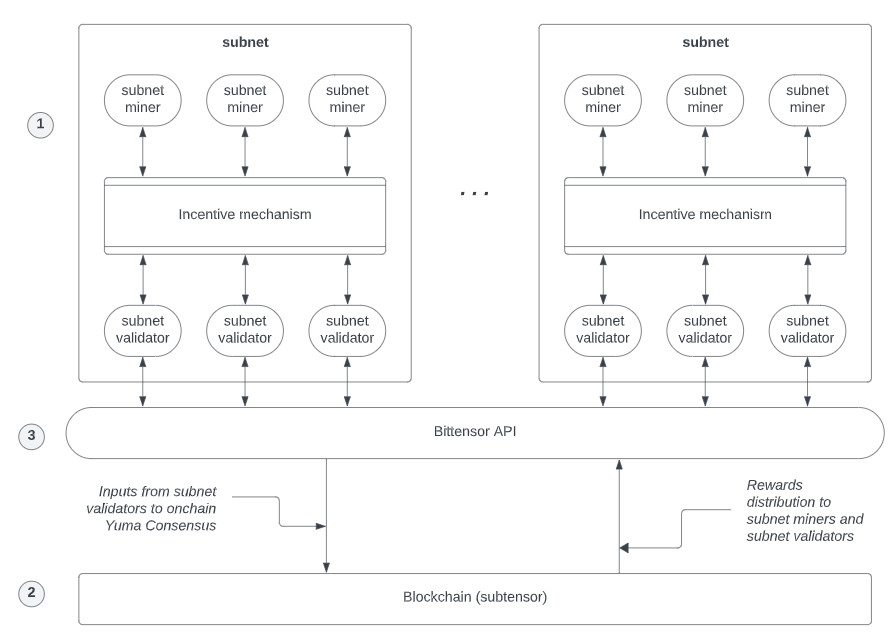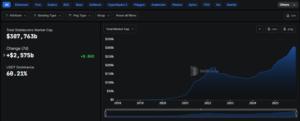
Artificial Intelligence or AI is a big sector. In crypto, we find many decentralized AI protocols. These are a good alternative to the centralized AI markets like ChatGPT. Bittensor ($TAO) is one of the decentralized leaders in the AI crypto sector. It connects and strengthens machine learning models.
So, let’s take a closer look at what Bittensor and its $TAO token are all about.
What Is Bittensor ($TAO)
Bittensor ($TAO) offers a Peer-to-Peer (P2P) network for an AI ecosystem. It also works as a decentralized protocol. This offsets centralized control of AI and siloed data. Centralized control makes it difficult to share or access data. On the other hand, Bittensor is an open-source protocol. In other words, anybody can access their source code. In turn, this encourages transparency and collaboration.
Bittensor does this by offering so-called subnets. All these subnets offer different AI-related machine learning models. This could be for compute power, storage space, or even in medical research. More on subnets later. The picture below shows the set-up of Bittensor and its subnets.

Source: Bittensor Docs
The idea is that all these subnet projects share their knowledge. This should form a neural network, or as Bittensor calls it, a ‘digital hive mind’. The network should grow and improve because all participants contribute. In other words, the machine learning models interact and learn from each other.
From their side, Bittensor incentivizes the subnet with its $TAO token. That’s where the P2P marketplace comes into the picture. Devs create their data models, train them, and trade them in the marketplace. With more valuable and accurate output, protocols get selected for the validation process. This, in turn, rewards them with $TAO tokens.
1. @bittensor_$TAO is the AI market leader, and if it performs well, the entire sector is set to benefit.
TAO focuses on decentralising AI research, and has already seen significant adoption in scientific communities. https://t.co/WFRTzKD1Kv
— Miles Deutscher (@milesdeutscher) November 29, 2024
Like Bitcoin, the $TAO token has a max supply of 21 million tokens. Bittensor also has a 4-year halving cycle, like Bitcoin. This reduces the issuance rate of new tokens. Nodes and validators ‘mine’ the $TAO token. You can find out more about the $TAO tokenomics in #2 of this deep dive.
The Bittensor Team
In 2021, Jacob Steeves and Ala Shaabana created Bittensor. This was part of the Opentensor Foundation. Steeves is the CEO, he has a background in AI, machine learning, and decentralized systems. Shaabana is a software engineer with a blockchain background. He plays an important role in technical development and innovation.
Other team members include, among others,
- Jacqueline Dawn is the Director of Marketing. She makes sure that there’s a global audience.
- Saeideh Motlagh is the blockchain architect. She shapes the technical infrastructure.
- Garrett Oetken is the CTO.
- Paul Swaim is the CIO (Chief Information Officer).
Every VC is suddenly hyping “AI x crypto”
⁰Meanwhile, Bittensor already did it:– Subnets with real utility.⁰- Functional AI economy.
– Mining real intelligence.They’re not ignoring it.⁰They’re just too late to the game.
⁰No allocation. No control. No narrative to sell.— shτbshτb (@shibshib89) March 31, 2025
Currently, the team has around 40 members. The team opted for a fair distribution approach, rather than traditional ways of fundraising. This set-up has much more community participation and fewer VCs.
How Does Bittensor Work?
So, as already mentioned, Bittensor is a decentralized network. As such, it interconnects machine learning (ML) models. It uses a different consensus mechanism, called Proof of Intelligence (PoI). This is also known as the Yuma Consensus (YC). With traditional blockchains, you mine or stake to receive rewards. However, with POI or YC, it depends on how valuable your ML contribution is.
Its main network is the Subtensor. This is the coordination layer. The subnets all have different, specific tasks. They are interconnected, but also independent and have three different players.
- Subnet Creators. These define the network rules and what kind of tasks it can perform. They can also have different validation methods.
- Miners. These provide computing power or AI models.
- Validators. These evaluate the quality of the miner’s work. They also determine the rewards.
ML models that provide more accurate and valuable output also receive more rewards. These rewards are in $TAO tokens. Validators that evaluate miners close to consensus also receive higher rewards.
However, this also caused governance issues. Until February 2024, Bittensor had centralized governance. There were 64 validators of the Root Subnet. 50% of the voting power was with the top 5 validators. Bias and favoritism also played a role. Hence, a new governance model was in order.
Introduction of Dynamic $TAO or $dTAO
By introducing $dTAO there’s now a decentralized governance mechanism. For instance, this also removed the roles of the 64 Root Subnet validators. It took a year to get to this governance model, but on 13th February 2025 it launched. It’s possible to stake on a subnet or stake on the Root Subnet. Here, you stake $TAO and receive $TAO as a reward. Subnet staking is explained below.
You can read the $dTAO whitepaper for a better understanding of it. However, that’s rather technical. For an easier explanation, check this OAK Research article or the Bittensor docs. The picture below shows the ecosystem before the $dTAO upgrade. Or check the video below.
Alpha Tokens
After this upgrade, each subnet has its own alpha token. However, you can’t trade them on a secondary market or exchange. You can only find them in dedicated liquidity pools for each subnet. In these liquidity pools, there are two tokens: $TAO and a subnet’s alpha token. You can see these tokens as a liquid staking token.
To get access to such a liquidity pool, you need to buy $TAO and stake it into a pool. Now you receive the subnet’s alpha token. The more $TAO and alpha tokens are in a pool; the higher the alpha’s price is. So, users staking their $TAO in subnets are now important.
The higher the price of an alpha token is, the more emissions it receives. The price of a subnet’s alpha is the ratio of $TAO in its reserve to alpha in reserve. Think of it as a sliding scale between native $TAO and the alpha tokens of your subnet of choice. So, alpha tokens may increase or decrease in $TAO value as the price of the alpha changes. When you unstake, you receive your $TAO tokens again.
The current $TAO price is $231.70. It has a market cap of $1.8 billion. Out of the 21 million $TAO tokens, 8.5 million circulate. Click here to read Part 2 of this series.
Disclaimer
The information discussed by Altcoin Buzz is not financial advice. This is for educational, entertainment and informational purposes only. Any information or strategies are thoughts and opinions relevant to accepted levels of risk tolerance of the writer/reviewers, and their risk tolerance may be different from yours.
We are not responsible for any losses that you may incur as a result of any investments directly or indirectly related to the information provided. Bitcoin and other cryptocurrencies are high-risk investments, so please do your due diligence.
Copyright Altcoin Buzz Pte Ltd.
The post Bittensor ($TAO) Deep Dive Part #1 appeared first on Altcoin Buzz.

